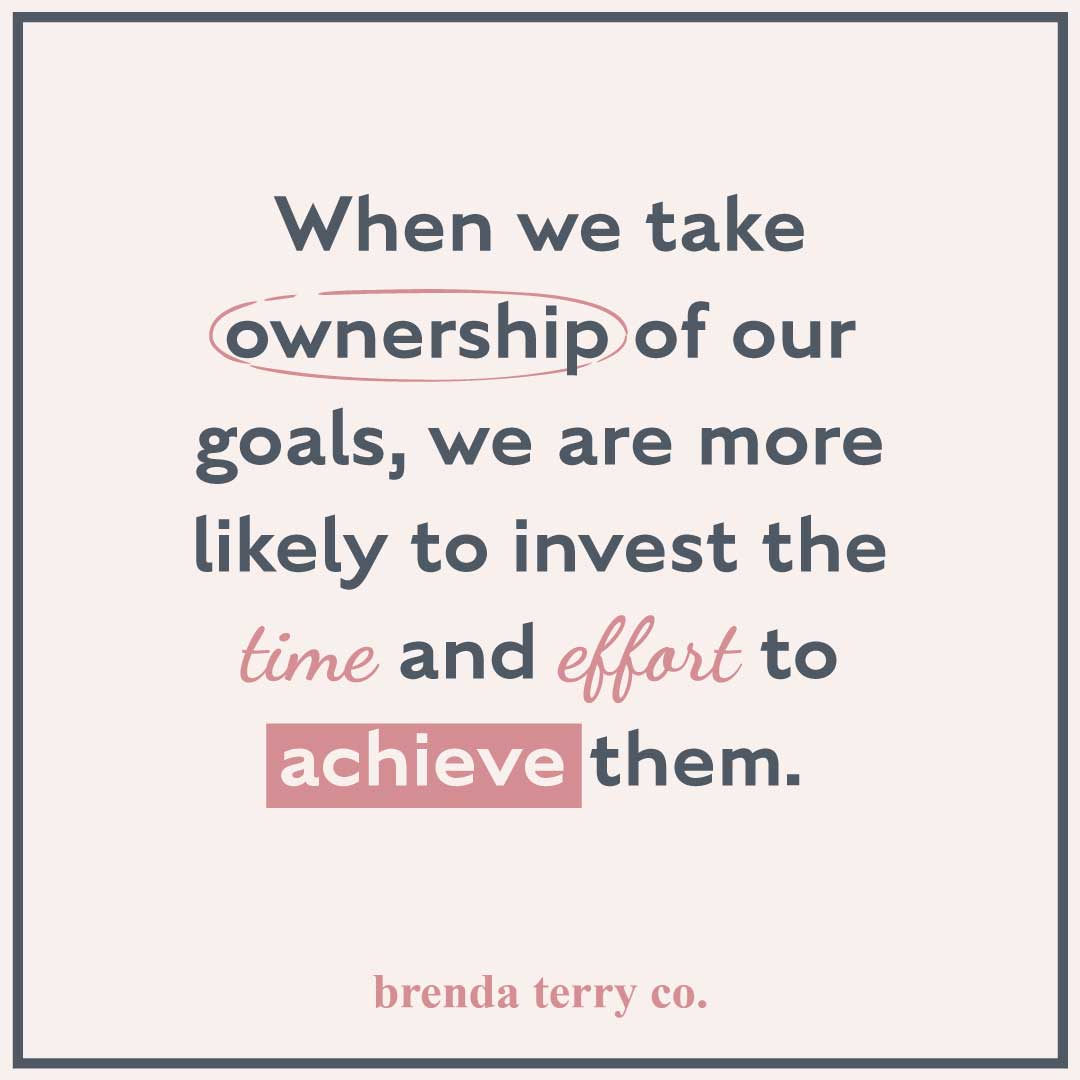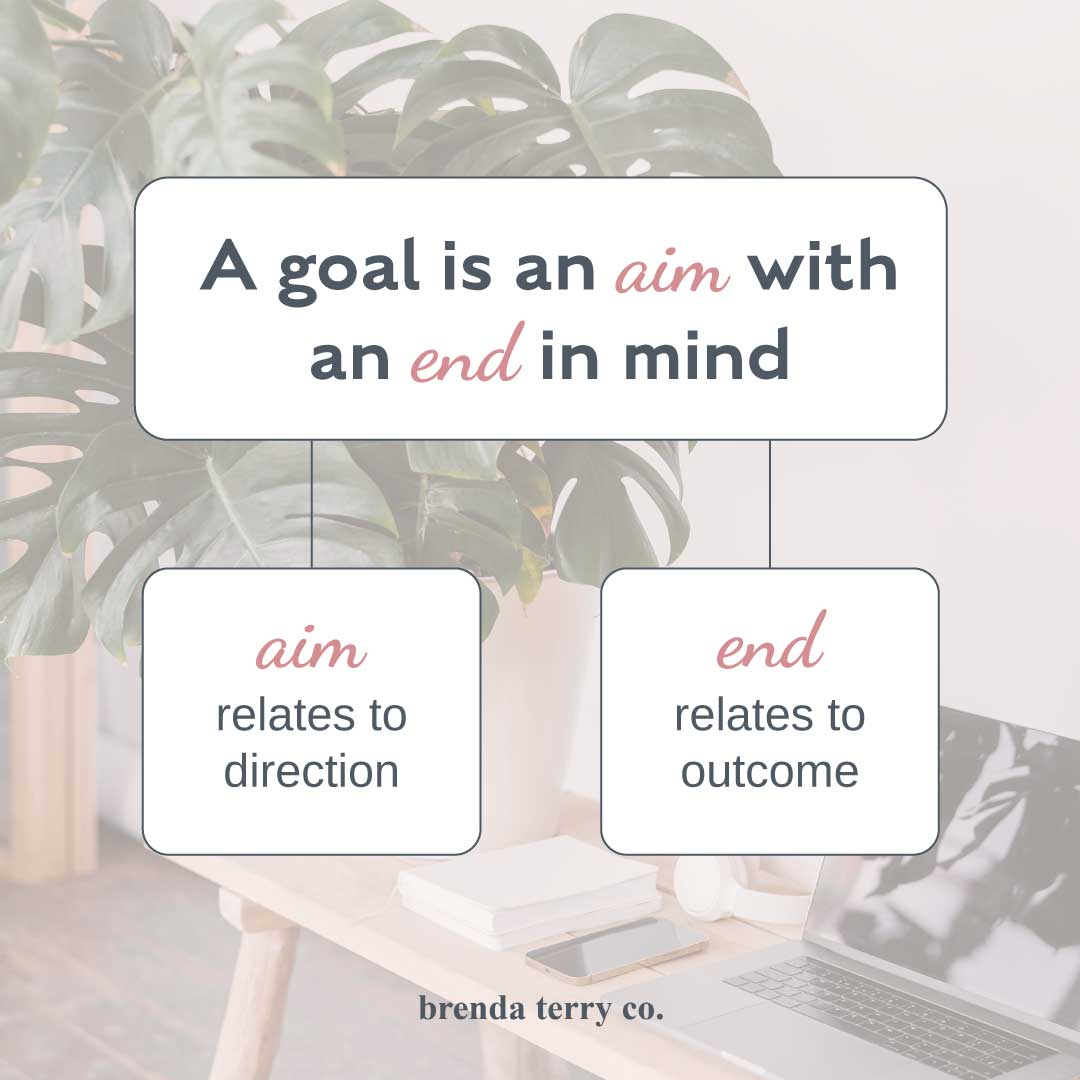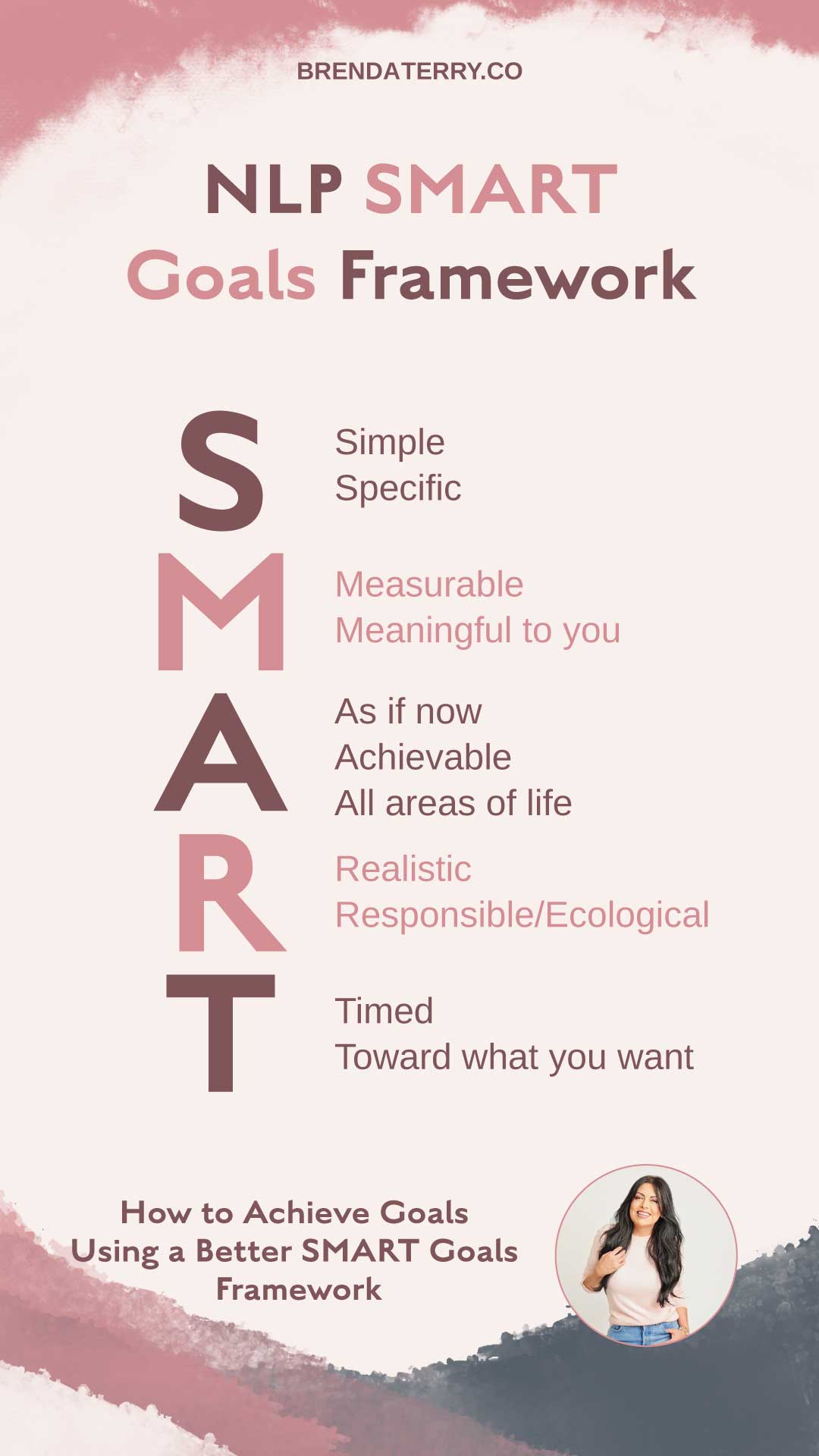
How to Achieve Your Goals Using A Better SMART Goals Framework
How to Achieve Your Goals Using A Better SMART Goals Framework
Table of Contents

Hey there! I’m Brenda Terry.
I’m a Mindset and Business Mentor and an NLP master coach trainer. I help you train your brain for success, break through mental and emotional blocks, reclaim your personal power, and take results-based action to finally get what you want in business and life.
Table of Contents
How to Achieve Goals Using A Better SMART Goals Framework?
Do you have something you want to achieve?
Everybody has something they want to achieve, whether it’s a specific goal or a general desire for success. This is where the SMART goals framework—setting specific, measurable, achievable, realistic, and timed goals—comes in.
You must have read about it in self-help books or listened to motivational speakers go on about it, but let’s be real. How many times have we set these types of goals and still haven’t been able to achieve what we wanted?
After helping clients and students achieve significant goals for years, I’ve discovered that the problem isn’t the SMART goals framework; it’s how we approach it.
In this blog post, you’ll learn how to set goals, how to increase success through a psychological phenomenon, how to use the SMART goals framework and enhance it using NLP, and some tips on overcoming obstacles.
Let’s dive in.
What is Goal Setting?
You’re on the planet to achieve some things. No one is here to stand still. We all have unique talents and passions that drive us forward. If you’re not setting and achieving those goals, chances are that you’re missing out on opportunities for growth, success, and the actualization of those talents and passions.
Goal setting is more than just a productivity hack; it’s fundamental to leading a purpose-driven life.
At its core, setting goals is about identifying what you want to achieve—be it in your personal life, your career, or even your relationships—and outlining a clear path to get there.
Whether you’re a student, an artist, an employee, or an entrepreneur, goal-setting is for everyone because it provides direction and purpose in our personal and professional lives.
With proper planning and execution, anyone can accomplish their dreams and aspirations. This is all about you being able to turn your dreams into goals and take action to achieve them.
Why is Goal Setting so Powerful?
The answer is pretty simple—because goal-setting gives you a roadmap. When you set a goal, you’re essentially marking your destination on a map and then figuring out the steps to get there. This process keeps you focused and puts you on a plan to make consistent progress despite potential distractions or setbacks.
Goal-setting also helps you identify what truly matters to you and what you want to prioritize in your life. It allows you to take control of your future and make intentional choices that align with your values and desires. Without clear goals, it’s easy to get lost in the day-to-day routines and lose sight of the bigger picture.
But goals aren’t just about keeping you on track; goals help you measure your progress.
For example, if your goal is to learn a new language, setting milestones for mastering specific phrases or grammar rules can help you gauge how far you’ve come and how far you still need to go.
Plus, the benefits of personal goals extend to growth and fulfillment. No matter how small, achieving a goal significantly boosts one’s self-esteem.
This isn’t just a feel-good moment; it helps boost your mental health. Each achievement triggers the release of dopamine, the brain’s reward neurotransmitter, making you feel happier and more fulfilled.
But the real magic of goal setting might be how it pushes us out of our comfort zones. We often have to stretch beyond our current capabilities to reach new heights. This might mean acquiring new skills, refining existing ones, or changing our approach to problems.
For example, if you’re aiming to run a marathon, you’ll gradually increase your endurance and speed, which are physical changes.
You will likely also develop the mental resilience to push through the last few miles of the race. These challenges encourage growth, not just in the specific area of the goal, but in overall life skills.
Now, let’s talk about adaptability and resilience. In today’s fast-paced world, these traits are gold. Actively pursuing our goals compels us to adapt as circumstances change.
For example, if your initial strategy for achieving a goal doesn’t work, you may need to change your approach.
This adaptability isn’t just about changing course; it’s about learning to thrive in the face of challenges, which in turn builds resilience.
So, whether you’re looking to improve your health, advance your career, or enrich your personal life, setting goals is a step toward not just dreaming big but making those dreams a reality.
The journey from setting a goal to reaching it is transformative, equipping you with a powerful mindset and direction to tackle whatever comes your way.

The Consequences of Not Setting Goals
Imagine sailing a boat without a definitive destination in mind. You might enjoy drifting with the current for a while, but soon, the charm fades as you realize you want to get somewhere specific.
This metaphor rings especially true in the context of our lives when we fail to set goals.
Research shows that people who don’t set goals are less likely to achieve their desired outcomes and tend to experience lower levels of life satisfaction.
That’s because, with clear objectives, we tend to find direction, purpose, and fulfillment. This dynamic can make it challenging to achieve desired outcomes, ultimately leading to lower levels of life satisfaction.
Why Does this Happen?
It’s simple: our minds crave direction. When we don’t set goals, it’s like telling our brain to run without giving it a destination.
The result? We end up “flapping in the wind,” directionless and unfulfilled, much like a kite without a string. This state can make daily activities feel aimless and unrewarding, making you lose motivation and discipline, the key components needed to navigate potential obstacles.
When we drift without goals, it’s easy to fall into a routine that lacks excitement or challenges. This monotony can rob us of our long-term aspirations, making us feel stuck.
Think about the times you’ve felt a vague dissatisfaction with life; isn’t it often linked to not pursuing or achieving something meaningful?
But when we set goals, our minds work towards them actively. Our brain becomes like a GPS, constantly recalculating and adjusting our actions to bring us closer to our desired destination.

The Endowment Effect: The Fuel Behind Achieving Goals
Now, science has also proven the value of taking ownership of our goals. This is where the endowment effect comes into play.
The endowment effect is a psychological phenomenon that allows us to take ownership of our goal, but it really applies to ownership of anything.
When we decide something is ours to achieve—whether it’s running a half marathon, starting a business, setting other team goals, or simply mastering a new skill—we naturally place more value on it.
This decision engages our unconscious mind, giving us immense self-confidence and setting us on a path to actively pursue and invest in our goal. It’s one of the most incredible ways to supercharge goal-setting techniques.
.

5 Characteristics of Well-Formed Goals
Now, let’s look at the characteristics of well-informed goals:
1) Stated Specifically
To achieve the desired outcome, you need to set specific goals. Setting clear goals will help you find direction, set a purpose, and strive for its fulfillment. Wondering why?
To steer your unconscious mind in the right direction.
Remember, your mind needs direction and purpose to work towards something. Specific goals provide that direction and reason.
So, setting goals gives a clear direction to the unconscious mind. Moreover, it gives you the motivation and discipline to work towards achieving the desired outcome.
2) Write Goals/Outcomes
When setting personal life goals or professional life goals, make sure you write them down. Writing down your goals helps you clarify what you want to achieve, and you can devise a plan to achieve them.
Writing goals also helps you track your progress and stay accountable. You can refer back to your written goals and see how far you’ve come, which can motivate you.
Look at it this way: writing goals gives you a sense of responsibility and encourages you to take ownership of them, which supports you in doing whatever it’s necessary to achieve them.
3) Time is Involved
Naturally, when we take ownership of our goals, we tend to invest time and effort to achieve them. You see how powerful this is and how one thing connects to the other.
When goals are time-bound, they give a timeline of how long it will take to achieve your desired goals.
So, decide how long it will take you to achieve your goal. This will help you plan your actions accordingly and stay on track.
4) Steps Needed To Get There
A well-formed goal includes identifying the steps needed to achieve your desired outcome. These steps are like a roadmap that guides you toward your ultimate goal.
When setting your goals, brainstorm all the possible actions needed to get there. Write them down and prioritize them in order of importance.
Having a clear plan of action will make it easier for you to stay focused and motivated throughout your journey towards achieving your goal.
5) Measurable
We have already established that the desired outcome of a set goal is action-based and measurable. Measuring progress when achieving goals is essential, as it allows you to track your success and make necessary adjustments if necessary.
Set specific, quantifiable targets for each step of your goal. This will give you a clearer picture of how far you have come and how much further you still have to go. It will also help you stay motivated by seeing tangible results along the way.

Understanding and Applying SMART Goals in Personal and Professional Success
When it comes to defining goals that can lead to remarkable achievements, the SMART goals framework is a tried and tested tool that many turn to for guidance.
In NLP, we say that a goal is an aim with an end in mind. Aim relates to the direction, and end relates to the outcome.
However, the NLP (Neuro-Linguistic Programming) SMART goals framework takes this concept a step further by including elements that make the process more interactive and tuned to personal growth and satisfaction.
As mentioned above, SMART goals are a well-recognized methodology for setting clear, achievable objectives. The acronym “SMART” stands for Specific, Measurable, Achievable, Realistic, and Timed.
Each part of the SMART framework plays a crucial role in creating effective goals that guide individuals and organizations toward success.
Let’s review the SMART goals in detail.
Specific and Simple
The specificity of a goal is its defining feature. A specific worthwhile goal clearly outlines what you must accomplish, making it easier for you to focus efforts and allocate time and resources effectively
Let’s take an example of professional goals here, instead of setting a vague undefined goal like “increase sales,” a specific goal would be “boost up sales by 10% within the next year”
Measurable and Meaningful
Measurable goals allow you to track progress and assess the outcome objectively. It lets you answer questions like ‘How much?’ or ‘How many?” This measurability ensures that you can calculate whether the target has been met.
For instance, if your goal is to “increase website traffic,” a measurable version would specify “increase website traffic by 20% over the next six months.”
Achievable, and As If Now, and In All Areas of Life
Goals should be attainable; when you set attainable goals, it means the goals are realistic and possible, given the available resources and time.
But we also want them to be something that you can imagine yourself doing as if it’s happening now. So we want you to visualize yourself as if it’s happening now and try that on.
Once you have achieved this goal and are even in the process of achieving it, we want every area of your life to benefit.
So that means you will gain some skills as you achieve the goal. And we want to be able to utilize those skills or parts of those skills in every area of our life. That is part of the structure of a very well-formed outcome.
An achievable goal motivates people with small wins, while an unattainable one can lead to frustration and discouragement. Balancing ambition with practicality to work towards your ultimate goal is crucial.
Realistic and Responsible/Ecological
Relevance refers to aligning the goal with bigger objectives. A realistic goal matters to the individual and the organization, contributing to larger strategic plans.
We want the goal to be realistic, but we also want the goal to be responsible or ecological, as we say in NLP.
So that means that you want to make sure that this goal is going to serve you, that it’s going to help you, but that it’s also going to benefit the people directly involved.
For personal development, relevant career goals might involve acquiring skills that advance one’s career path, whereas, for a business, it could focus on areas that enhance competitive advantage.
Timed and Toward What You Want
A time-bound goal has a deadline. This characteristic instills a sense of urgency and prompts action. Setting a timeline helps prioritize tasks, manage time effectively, and maintain momentum.
Whether it’s for short-term goals of completing a project within three months or learning a new skill within a year, time-sensitive goals push for making progress and prevent tasks from being unnecessarily postponed.

6 Tips for Successful Goal Achievement
Here are the steps that your goal setting process should have:
1) Write It Down
When you pen down the goals, the chance of achieving them increases. Writing down goals clears your mind and constantly reminds you of what you want to achieve.
It also helps clarify your thoughts and serves as a constant reminder of what you’re working towards.
2) Make The Goal So That It Can Be Maintained By You
When you set the goal, you take ownership, and you have control. Setting achievable and realistic goals will give you the sense of authority required to reach the end.
For example, you set a goal of earning a million dollars in 1 month. This goal is too ambitious and is not realistic. A more realistic goal would be to increase your income by 10% every month.
3) Clearly Define The Steps Required To Reach Your Goal
It’s better to break larger goals into manageable tasks when striving to achieve milestones. A clear plan helps you stay focused and motivated to achieve your goal.
4) Ensure There’s More Than One Way To Get The Outcome You Desire
Always have a backup plan. Plans tend to fail. If your initial plan doesn’t work out, develop alternative ideas to keep yourself on track.
5) Only Set Goals That Increase Your Overall Choices
Eventually, all goals should lead to personal growth and improvement. Also, they should provide you with opportunities to explore, gain knowledge and acquire skills.
6) Make Adjustments As Necessary
Assess your goals from time to time and make adjustments along the way. Be flexible and change course whenever necessary because you learn different things when you move forward. If need be, you can always modify your original goal.

Final Words
It’s important to recognize that encountering obstacles while pursuing your goals is inevitable and invaluable. However, looking at these challenges as not setbacks but milestones indicating progress toward your goals and personal growth is important.
Each obstacle you face is a sign of the fact that you are stepping out of your comfort zone and evolving. Rather than feeling discouraged, consider these moments as opportunities to improve your understanding and refine your strategies.
Viewing obstacles through this positive lens automatically transforms them into learning experiences, enhancing your journey and resilience. You need to learn how to change your mindset. This mindset shift is crucial because it aligns with the broader purpose of personal development, which is not merely to achieve specific goals but to grow and expand as individuals throughout the process.
The true reward lies in this evolution—achieving challenging goals is a stepping stone to becoming a more capable, confident, and self-aware individual, so make sure you celebrate small wins, too.
Lastly, embrace each challenge with open arms, look at what each one teaches you, and use that knowledge to move yourself forward. By doing so, you continually build a strong base for reaching your goals and exceeding them based on the goal-setting theory given above, creating a fulfilling and enriching life and making your brief time in this world worthwhile.

Table of Contents

Hey there!
I'm Brenda Terry
I'm a Mindset and Business Mentor and an NLP master coach trainer. I help you train your brain for success, break through mental and emotional blocks, reclaim your personal power, and take results-based action to finally get what you want in business and life.
This blog is where I share my insights, tips, and strategies for personal growth, mindset mastery, and business success. My goal is to empower you to reach your full potential and create a life of purpose, passion, and abundance.

Hey there!
I'm Brenda Terry
I'm a Mindset and Business Mentor and an NLP master coach trainer. I help you train your brain for success, break through mental and emotional blocks, reclaim your personal power, and take results-based action to finally get what you want in business and life.
This blog is where I share my insights, tips, and strategies for personal growth, mindset mastery, and business success. My goal is to empower you to reach your full potential and create a life of purpose, passion, and abundance.



